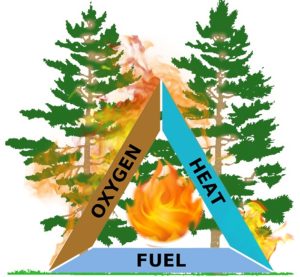Forest Fires and Mitigation Methods
HOT ISSUES FOR MAINS(TOPIC #12)( SecureIas Initiative)
 Forest Fires, both man-made and natural, contribute to forest loss. Fire is the oldest method used to clear land for farming and other uses. This is a concern not only because of the added threat to biodiversity and other natural systems, but deforestation—especially by fire—is also a key emitter of carbon dioxide.
Forest Fires, both man-made and natural, contribute to forest loss. Fire is the oldest method used to clear land for farming and other uses. This is a concern not only because of the added threat to biodiversity and other natural systems, but deforestation—especially by fire—is also a key emitter of carbon dioxide.
- Reasons = mono culture of pine is responsible(oil present in the needles) + 90% fire by humans + shift and burn culture + clear fields and fresh grass
- Why no/less control = forest personnel are too less and don’t have adequate infrastructure and even safety guards for themselves + difficult terrain making difficult to control fires + paucity of fund to control fire + fire lines have been destroyed (roads made in British era to reach fire areas and control fires)
- Climate change impact = impact of industrialization,global warming and climate change—> heat trapping and dry leaves –> more forest fires
- Impacts = it in turn increasing global warming + health hazards + harmful to full biodiversity
- Remedies = less exploitation + pine management + more funds + more forest personnel + involvement of locals in forest departments + fire lines + multi species plantation promotion.
Causes of Forest Fires
1. Natural causes
2. Man-made causes
3. Unintentional or Accidental fire
4. Fires due to collection of minor forest produce
5. Fires due to logging operations
6. Fires due to management reasons
Damage from Forest Fires
1. Destruction of seeds
2. Destruction of young seedlings
3. Damage of young plants and trees
4. Deterioration of site
5. Injury to wildlife
Control of Forest Fires
1. Preventive measures
2. Combative measures
3. Remedial measures
Fire Prevention Methods
1. Relationships with public
2. Personal contact
3. Special campaigns
4. Religious sermons
5. Training
6. Public awareness
Preparedness and Mitigation Measures
- Forest fires are usually seasonal. They usually start in the dry season and can be prevented by adequate precautions.
- During the British period, fire was prevented in the summer through removal of forest litter all along the forest boundary. This was called “Forest Fire Line” This line used to prevent fire breaking into the forest from one compartment to another. The collected litter was burnt in isolation. Generally, the fire spreads only if there is continuous supply of fuel (Dry vegetation) along its path. The best way to control a forest fire is therefore, to prevent it from spreading, which can be done by creating firebreaks in the shape of small clearings of ditches in the forests.
Precautions
The followings are the important precautions against fire:
- To keep the source of fire or source of ignition separated from combustible and inflammable material.
- To keep the source of fire under watch and control.
- Not allow combustible or inflammable material to pile up unnecessarily and to stock the same as per procedure recommended for safe storage of such combustible or inflammable material.
- To adopt safe practices in areas near forests viz. factories, coalmines, oil stores, chemical plants and even in household kitchens.
- To incorporate fire reducing and fire fighting techniques and equipment.
By: Sugam Bansal+ Ashish Kumar

 Forest Fires, both man-made and natural, contribute to forest loss. Fire is the oldest method used to clear land for farming and other uses. This is a concern not only because of the added threat to biodiversity and other natural systems, but deforestation—especially by fire—is also a key emitter of carbon dioxide.
Forest Fires, both man-made and natural, contribute to forest loss. Fire is the oldest method used to clear land for farming and other uses. This is a concern not only because of the added threat to biodiversity and other natural systems, but deforestation—especially by fire—is also a key emitter of carbon dioxide.